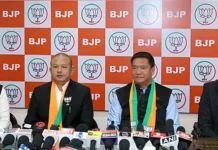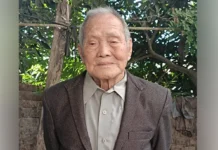[ Prem Chetry ]
BOMDILA, 25 Nov: In an effort to revive the ancient Indo-Tibetan pilgrimage site Dakpa Sheri, also known as Crystal Mountain, a three-day National Conference on Nalanda Buddhism and the importance of the Dakpa Sheri pilgrimage at Taksing village in Upper Subansiri district concluded on Monday. The event was organized by the Indian Himalayan Council of Nalanda Buddhist Tradition (IHCNBT).
Advocate Maling Gombu, general secretary of IHCNBT bysaid, “The purpose of the pilgrimage and conference is to explore the possibility of opening, as well as reviving, the Tsari pilgrimage route between the two countries. It is one Yatra in two countries.”
“The border is hotly contested between the two nations, so the opening of this corridor would help foster a cordial relationship between the two countries through pilgrimage diplomacy, similar to the Kartarpur Corridor and the Mt. Kailash corridor from Nathula, Lepu Lake, Shipkila Pass, etc.,” he added.
Gombu expressed hope, saying, “We are hopeful that the Government of India will take up the matter with its counterpart, and that something will come of it soon, so as to enable the start of the holy Tsari pilgrimage by 2028, the Year of the Monkey, marking the completion of one cycle of 12 years.”
The team visited the pilgrimage area at Yume Chu, the confluence of the Yume and Chayul rivers, a holy site for the Dakpa Sheri and Tsari pilgrimage route, from where pilgrims once took different routes to the Yume and Chayul sides-the parting places where they would go to complete the pilgrimage.
There are also other significant pilgrimage sites in and around Taksing village, including the meditation cave of Guru Padmasambhava, the holy tree, and the rock used for offerings by Dakinis, called Yeshi Khandomas, all of which have great Buddhist significance.
Speaker Claude Arpi, Tibetologist and author, citing the importance of Tsari and other pilgrimage sites under Tibetan administration, spoke on Captain Bailey’s Route, Southeast Tibet (1912), Captain Henry Morshead’s Map, the Simla Conference of 1913-14, the McMahon Line (March 1914), the Tibet-Birdet Age, the Tsari Sector Survey of India (1914), NEFA and Tibetan influence, and the entry of the PLA into Lhasa in September 1951.
Meanwhile, Khensur Jangchup Choeden Rinpoche, secretary general of the International Buddhist Confederation (IBC), ministry of culture, government of India; Tenzin Rinpoche of Chillipam Monastery, West Kameng district; and others spoke on the spiritual significance of the place.
Among others, the conference was attended by officiating CO, 4th Garhwal Regiment, Major Ashok; Deputy Commandant Virender Singh, 31st Battalion, ITBP; Yeshi Tsering, member of the Lok Ayukta; Tsering Nakseng, former member of APPSC; Mamta Riba, director of land management; Karma Leki, joint secretary of the home department; ZPM Natuk Mra, president of the Taksing Buddhist Society; and general secretary Tache Chadar of the Nah Welfare Society.




